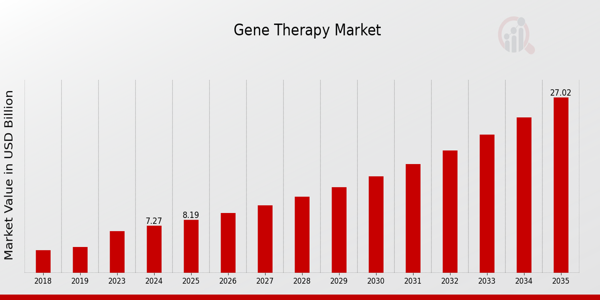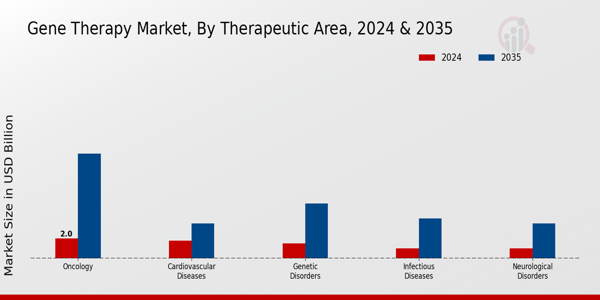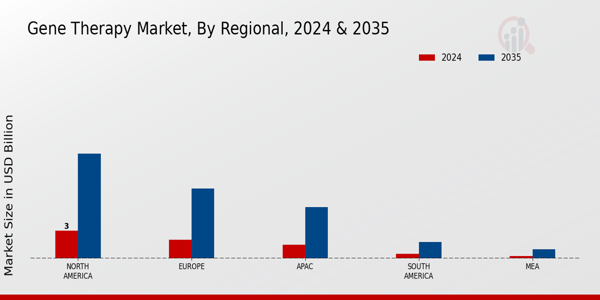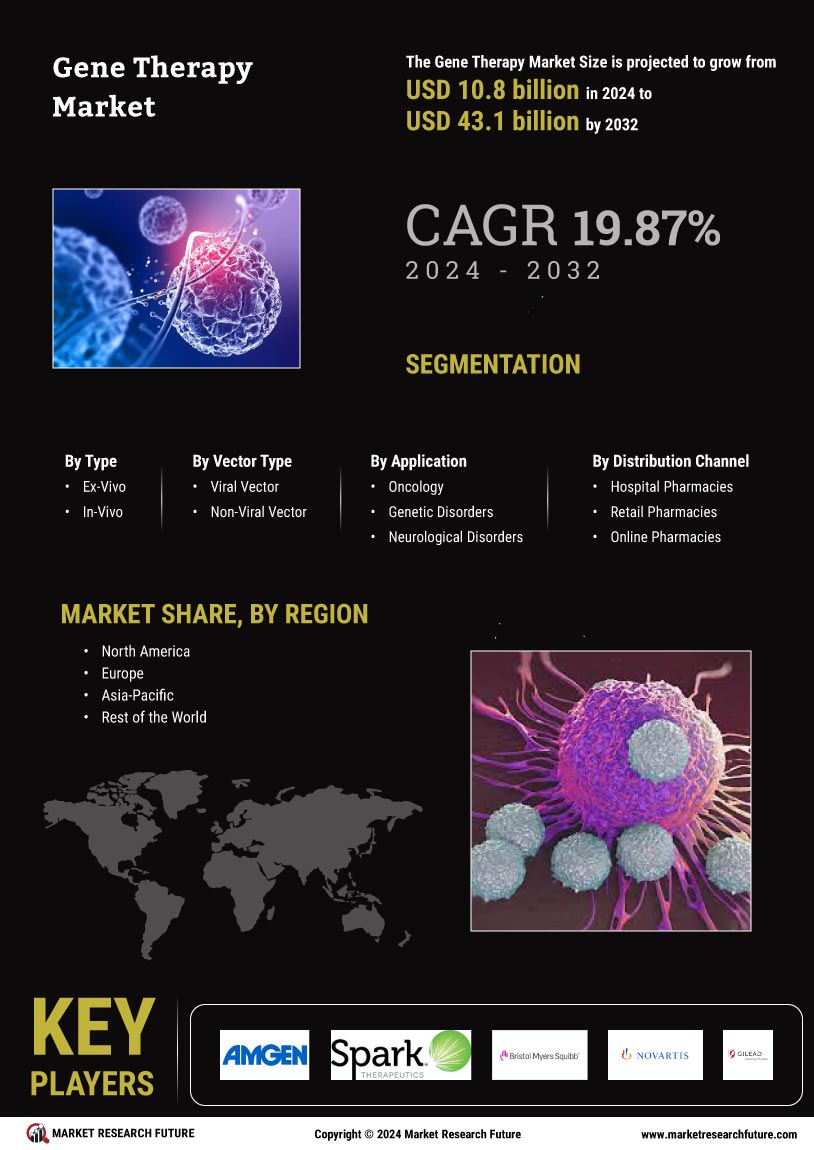Gene Therapy Market Overview
As per MRFR analysis, the Gene Therapy Market Size was estimated at 6.45 (USD Billion) in 2023. The Gene Therapy Market Industry is expected to grow from 7.27(USD Billion) in 2024 to 27 (USD Billion) by 2035. The Gene Therapy Market CAGR (growth rate) is expected to be around 12.68% during the forecast period (2025 - 2035).
Key Gene Therapy Market Trends Highlighted
The Global Gene Therapy Market is experiencing several significant trends that shape its growth trajectory. One of the key market drivers is the increasing prevalence of genetic disorders, which fuels the demand for effective therapeutic solutions. Governments and health organizations across the globe are recognizing the potential of gene therapies to address these unmet needs, creating an environment conducive to research and investment in this field. Moreover, advancements in gene editing technologies, such as CRISPR and AAV vectors, have sparked innovation and contributed to the development of more efficient and targeted therapies.
Opportunities to be explored include the expansion of gene therapy applications beyond rare genetic disorders to more common diseases, such as cardiovascular diseases and certain types of cancer. As regulatory frameworks evolve, the pathway for bringing new therapies to market is becoming more streamlined, which amplifies the opportunities for both established companies and startups in the sector. Additionally, collaborations between academic institutions, biotech firms, and pharmaceutical companies are on the rise, leading to enhanced research initiatives and broader licensing agreements.
Recent trends showcased in the Global market include a significant rise in clinical trials focusing on gene therapies, indicative of increased confidence in their safety and efficacy. Policymakers and health agencies are promoting initiatives to foster innovation and investment in gene therapies, further accelerating development. The rise of personalized medicine is also a prominent trend, as therapies that are tailored to individual genetic profiles are gaining traction. These developments contribute to a dynamic environment in the Global Gene Therapy Market, offering a forward-looking perspective on the potential future landscape in healthcare.

Source: Primary Research, Secondary Research, MRFR Database and Analyst Review
Gene Therapy Market Drivers
Rising Prevalence of Genetic Disorders
The rising incidence of genetic illnesses is propelling the global gene therapy market industry's notable expansion. Globally, the prevalence of genetic illnesses has increased over the last ten years; according to the World Health Organization, approximately 300 million individuals have uncommon genetic diseases. There is an immediate need for novel treatments due to the expanding patient base. The vital need for gene treatments to treat these illnesses has been recognized by institutions like the National Institutes of Health, which has supported financing and research efforts.
As these treatments progress through the stages of research and development, they give patients hope and propel the market, underscoring the need to launch innovative treatments in different parts of the world, particularly in developed nations with advanced healthcare infrastructures.
the Advancements in Gene Editing Technologies
Technological innovations in gene editing, especially the advancement of CRISPR-Cas9 and other gene editing tools, are significantly bolstering the Global Gene Therapy Market Industry. These technologies have made it faster and more cost-effective to develop targeted gene therapies, enabling personalized medicine approaches. The National Academy of Sciences has indicated that techniques such as CRISPR can potentially treat diseases that previously had no cure, demonstrating a profound impact on global health.
With continued investment from biotechnology companies and research institutions, the growth of gene editing capabilities fosters a robust pipeline of new therapies aimed at treating various genetic conditions, thereby propelling the market.
Supportive Regulatory Frameworks
The Global Gene Therapy Market Industry is benefiting greatly from supportive regulatory frameworks established by governmental agencies worldwide. Authorities such as the U.S. Food and Drug Administration and the European Medicines Agency have implemented expedited pathways for gene therapy approvals, recognizing the critical needs within this niche segment. Recent regulations aimed at facilitating quicker access to innovative treatments underscore a commitment to addressing unmet medical needs in genetic and rare diseases.
According to industry insights, these regulatory incentives have resulted in a notable 50% increase in gene therapy approvals over the last five years. This encouraging regulatory environment enhances market growth prospects by promoting the availability of new therapies across global markets.
Gene Therapy Market Segment Insights:
Gene Therapy Market Therapeutic Area Insights
The Global Gene Therapy Market, particularly within the Therapeutic Area segment, is witnessing significant growth, with the overall market valuation of 7.27 USD Billion in 2024 and expanding to 27.0 USD Billion by 2035. This expansive growth underscores the increasing interest and investment in gene therapies targeting various conditions. Among the key focus areas, Oncology stands out as a prominent segment, valued at 2.0 USD Billion in 2024, which is expected to surge to 10.5 USD Billion by 2035, highlighting its major role in addressing cancer treatment and the rising prevalence of cancer globally.
Genetic Disorders occupy another critical niche, with a current valuation of 1.5 USD Billion set to reach 5.5 USD Billion in 2035. The rising incidence of hereditary diseases drives the demand for genetic therapies aimed at curing or managing these conditions effectively. The segment for Infectious Diseases, although currently smaller at 1.0 USD Billion in 2024, is anticipated to grow to 4.0 USD Billion by 2035, fueled by advancements in gene-based therapies targeting viral infections and other pathologies.
Cardiovascular Diseases, representing an essential therapeutic area, holds a value of 1.77 USD Billion in 2024 and is projected to experience growth to 3.5 USD Billion by 2035, underlining the potential of gene therapy to revolutionize treatment options for heart conditions. Lastly, Neurological Disorders, with a valuation of 1.0 USD Billion in 2024, are expected to rise to 3.5 USD Billion by 2035, reflecting a significant need for innovative therapies in managing debilitating neurological conditions.
Each of these segments not only exhibits robust growth potential but also illustrates the increasing role of gene therapies in transforming treatment landscapes in the Global Gene Therapy Market as stakeholders recognize the efficacy and promise of these innovative solutions. The robust growth in the Global Gene Therapy Market revenue across various therapeutic areas is driven by advances in research, regulatory approvals, and a greater understanding of genetic diseases, creating unique opportunities that collectively shape the market landscape.

Source: Primary Research, Secondary Research, MRFR Database and Analyst Review
Gene Therapy Market Technology Insights
The Technology segment of the Global Gene Therapy Market showcases a dynamic landscape driven by innovative approaches aimed at harnessing the power of genetic modification. In 2024, this segment contributes significantly to the overall market valuation projected at 7.27 USD Billion, reflecting a robust demand for therapeutic solutions. Within this segment, Viral Vectors are critical for delivering genetic material effectively into target cells, capturing a considerable share of interest in clinical applications.
Additionally, CRISPR technology has revolutionized gene editing by providing precise and efficient methods, facilitating advancements in Research and Development. Meanwhile, RNA Therapy is gaining traction for its potential to address various genetic disorders through modulation of gene expression. Non-Viral Methods, although traditional, continue to present unique advantages, contributing to the diversity of gene therapy solutions available. The interplay among these technologies drives market growth, presenting both challenges in regulatory pathways and opportunities for collaborative developments that could reshape therapeutic practices on a global scale.
Gene Therapy Market Application Insights
The Global Gene Therapy Market is experiencing significant growth, valued at 7.27 billion USD by 2024, with the Application segment playing a crucial role in this expansion. This segment encompasses various categories, including Research, Clinical, and Commercial applications. Research serves as a foundation for innovations in gene therapy, contributing to advancements and breakthroughs that pave the way for new therapies. Clinical applications focus on utilizing gene therapy to treat and address a wide array of genetic disorders, making it a vital component that drives patient outcomes and enhances therapeutic efficacy.
On the other hand, the Commercial aspect highlights the increasing number of gene therapies entering the market, indicating a growing acceptance of gene-based treatments by healthcare providers and patients alike. The Global Gene Therapy Market segmentation reflects the diverse opportunities across these applications, driven by factors such as the rising prevalence of genetic conditions and ongoing technological advancements. Furthermore, the demand for personalized medicine is also a significant growth driver, solidifying the importance of each application in the overall landscape of the market.
Overall, developments in these areas are expected to propel the market further, fostering a robust environment for research, clinical implementation, and commercialization of gene therapies globally.
Gene Therapy Market Route of Administration Insights
The Global Gene Therapy Market revenue is valued at 7.27 billion USD in 2024 and is expected to experience substantial growth, reflecting the evolving landscape of gene therapy applications. The Route of Administration plays a crucial role in the effectiveness of gene therapies, impacting patient treatment regimens and outcomes. Within this segment, multiple methods are being explored, including Intravenous, Intramuscular, Intradermal, Intrathecal, and Oral routes. Intravenous administration is often favored due to its rapid delivery directly into the bloodstream, leading to quicker therapeutic effects and a significant patient preference.
On the other hand, Intramuscular injections are gaining attention for vaccines and therapies requiring localized delivery. Intradermal administration shows promise for certain applications, particularly in targeting skin-related genetic disorders, while Intrathecal offers a specialized means for treating central nervous system conditions. Oral administration is also gaining traction for its ease of use, potentially enhancing patient compliance.
The evolving preferences, regulatory advancements, and rising incidences of genetic disorders are driving demand in this segment, thereby supporting growth opportunities and influencing Global Gene Therapy Market statistics. As the gene therapy field continues to mature, understanding these routes will be pivotal for enhancing treatment efficacy and patient satisfaction.
Gene Therapy Market Regional Insights
The Regional segmentation of the Global Gene Therapy Market reveals a dynamic landscape characterized by differing growth trajectories across various territories. In 2024, North America leads the market valuation at 3.0 USD Billion, reflecting its majority holding and dominance due to robust healthcare infrastructure and significant investment in Research and Development. Europe follows closely, valued at 2.0 USD Billion, with increasing governmental support for gene therapy initiatives aiding its growth.
The Asia-Pacific (APAC) region is valued at 1.5 USD Billion, showcasing a rising interest in gene therapies driven by a large population and advancing biomedical research. South America, while smaller at 0.5 USD Billion, is gradually gaining momentum due to improved healthcare access and rising awareness of genetic diseases. Meanwhile, the Middle East and Africa (MEA) market stands at 0.27 USD Billion, indicating its nascent stage but with potential for growth as healthcare innovations penetrate the region.
This diverse valuation across regions shows the varying degrees of maturity and investment in gene therapies, providing a broader view of the Global Gene Therapy Market statistics and opportunities for expanding therapeutic applications.

Source: Primary Research, Secondary Research, MRFR Database and Analyst Review
Gene Therapy Market Key Players and Competitive Insights
The Global Gene Therapy Market has been experiencing substantial growth and transformation fueled by continuous advancements in cancer treatment, rare disease management, and inherited disorders. Competitive insights within this market reveal a dynamic landscape where numerous players strive to innovate and capture market share through the development of novel therapies, strategic partnerships, and collaborations. Companies are heavily investing in research and development to advance their product pipelines and enhance therapeutic efficacy. The competitive environment is characterized by a combination of established pharmaceutical giants and emerging biotech firms, each leveraging their unique strengths to drive growth and improve patient outcomes using gene editing technologies, vector development, and personalized medicine.
Furthermore, regulatory approvals and clinical trial successes have become pivotal in shaping competitive dynamics, leading to an increasingly crowded market as various entities vie to establish themselves as leaders in gene therapy solutions. UniQure stands out in the Global Gene Therapy Market due to its pioneering efforts in developing innovative therapies aimed at addressing genetic disorders. The company has made remarkable strides with its lead product, which focuses on treating specific rare genetic conditions, showcasing a strong commitment to addressing unmet medical needs through advanced genetic treatment options.
UniQure's strengths lie in its robust clinical trial portfolio, strategic partnerships with academic institutions for research, and a comprehensive understanding of gene therapy methodologies. By leveraging its proprietary AAV technology platform, UniQure has positioned itself as a key player in the market, equipped with the expertise necessary to navigate the complexities of gene therapy development. The company has also established a strong market presence supported by its innovative pipeline, enabling it to maintain competitiveness in a rapidly evolving industry.
GenSight Biologics has emerged as a noteworthy contender in the Global Gene Therapy Market, primarily focusing on developing gene therapies for ocular diseases. The company's key products target vision restoration, leveraging innovative gene therapies that harness the power of optogenetics to treat patients with retinitis pigmentosa and other vision impairments. GenSight Biologics has developed a solid market presence through successful clinical trials and partnerships with leading research institutions, which have facilitated advancements in its product offerings.
The company’s strengths include a specialized focus on the ocular gene therapy sector and a commitment to patients suffering from inherited visual disorders. Additionally, GenSight Biologics has actively pursued mergers and acquisitions to enhance its capabilities and expand its research horizon, contributing to the overall growth of the gene therapy landscape. This strategic approach not only bolsters their market position but also supports their goal of bringing transformative vision therapies to a global audience, ultimately improving the quality of life for patients around the world.
Key Companies in the Gene Therapy Market Include:
- UniQure
- GenSight Biologics
- AbbVie
- Gilead Sciences
- Roche
- Audentes Therapeutics
- Sangamo Therapeutics
- Poseida Therapeutics
- Vaxart
- CRISPR Therapeutics
- Novartis
- Freeline Therapeutics
- BristolMyers Squibb
- Spark Therapeutics
- Bluebird Bio
Gene Therapy Market Industry Developments
The Global Gene Therapy Market has witnessed significant advancements in recent months, particularly with companies like UniQure, GenSight Biologics, and AbbVie making strides in developing innovative therapies. In September 2023, Gilead Sciences announced positive results from trials concerning their gene therapy aimed at rare genetic disorders, further solidifying their position in the competitive landscape. Roche has also been expanding its portfolio, focusing on personalized gene therapies and enhancing patient outcomes.
Additionally, in August 2023, Audentes Therapeutics was acquired by Astellas Pharma, a move that will bolster Astellas's capabilities in gene therapy, further driving the market's growth. Another noteworthy development is the collaboration between CRISPR Therapeutics and Novartis to accelerate the development of CRISPR-based therapies. The market valuation of companies like Bluebird Bio has shown growth, attributed to advancements in technology and regulatory approvals, impacting overall market dynamics positively.
Over the last couple of years, there have been continued investments in Research and Development across the sector, with major players like Bristol Myers Squibb and Spark Therapeutics focusing on therapies for inherited diseases, indicating a robust growth trajectory for the Global Gene Therapy Market.
Gene Therapy Market Segmentation Insights
Gene Therapy Market Therapeutic Area Outlook
- Oncology
- Genetic Disorders
- Infectious Diseases
- Cardiovascular Diseases
- Neurological Disorders
Gene Therapy Market Technology Outlook
- Viral Vectors
- CRISPR
- Gene Editing
- RNA Therapy
- Non-Viral Methods
Gene Therapy Market Application Outlook
- Research
- Clinical
- Commercial
Gene Therapy Market Route of Administration Outlook
- Intravenous
- Intramuscular
- Intradermal
- Intrathecal
- Oral
Gene Therapy Market Regional Outlook
- North America
- Europe
- South America
- Asia Pacific
- Middle East and Africa
| Report Attribute/Metric Source: |
Details |
| MARKET SIZE 2023 |
6.45(USD Billion) |
| MARKET SIZE 2024 |
7.27(USD Billion) |
| MARKET SIZE 2035 |
27.0(USD Billion) |
| COMPOUND ANNUAL GROWTH RATE (CAGR) |
12.68% (2025 - 2035) |
| REPORT COVERAGE |
Revenue Forecast, Competitive Landscape, Growth Factors, and Trends |
| BASE YEAR |
2024 |
| MARKET FORECAST PERIOD |
2025 - 2035 |
| HISTORICAL DATA |
2019 - 2024 |
| MARKET FORECAST UNITS |
USD Billion |
| KEY COMPANIES PROFILED |
UniQure, GenSight Biologics, AbbVie, Gilead Sciences, Roche, Audentes Therapeutics, Sangamo Therapeutics, Poseida Therapeutics, Vaxart, CRISPR Therapeutics, Novartis, Freeline Therapeutics, BristolMyers Squibb, Spark Therapeutics, Bluebird Bio |
| SEGMENTS COVERED |
Therapeutic Area, Technology, Application, Route of Administration, Regional |
| KEY MARKET OPPORTUNITIES |
Increased investment in R&D, Growing prevalence of genetic disorders, Advancements in delivery mechanisms, Expanding FDA approvals, Rise of personalized medicine approaches |
| KEY MARKET DYNAMICS |
Rising prevalence of genetic disorders, Advancements in CRISPR technology, Increasing R&D investments, Regulatory support and framework, Growing patient awareness and acceptance |
| COUNTRIES COVERED |
North America, Europe, APAC, South America, MEA |
Gene Therapy Market Highlights:
Frequently Asked Questions (FAQ) :
The Global Gene Therapy Market is expected to be valued at 7.27 USD Billion in 2024.
In 2035, the Global Gene Therapy Market is projected to reach a value of 27.0 USD Billion.
The expected compound annual growth rate (CAGR) for the Global Gene Therapy Market from 2025 to 2035 is 12.68%.
By 2035, North America is expected to hold the largest market share, valued at 11.25 USD Billion.
The oncology segment is valued at 2.0 USD Billion in the Global Gene Therapy Market for the year 2024.
The genetic disorders segment is projected to reach 5.5 USD Billion in 2035.
Key players in the Global Gene Therapy Market include UniQure, AbbVie, Gilead Sciences, and Novartis.
The infectious diseases segment is valued at 1.0 USD Billion in the Global Gene Therapy Market for 2024.
Challenges include regulatory hurdles and high development costs for gene therapy products.
The cardiovascular diseases segment is expected to reach 3.5 USD Billion in 2035.

















